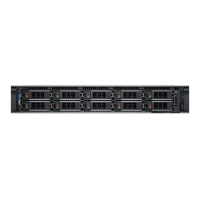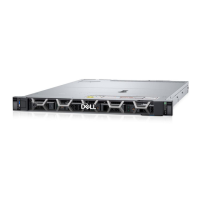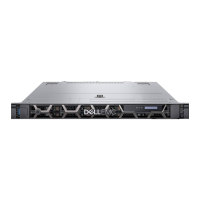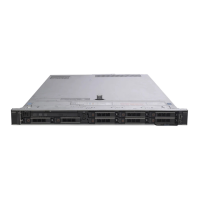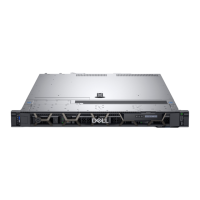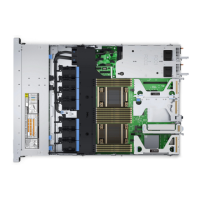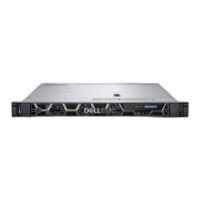





Do you have a question about the Dell PowerEdge R610 and is the answer not in the manual?
Explains keystrokes for accessing system features during startup.
Describes front-panel indicators and features, including power button and NMI button.
Details the system's LCD panel for displaying system information and status messages.
Describes user-configurable information displayed on the LCD Home screen.
Explains the meaning of LED indicators on power supplies for status and faults.
Explains the meaning of link and activity indicators on network interface controllers (NICs).
Explains messages displayed on the LCD panel related to system events and errors.
Explains messages that appear on screen to notify of potential system problems.
Alerts about potential problems and prompts for user response before task continuation.
Explains messages issued by system diagnostic utilities during tests.
Describes messages generated by system management software for various conditions.
Directs users to safety, regulatory, and other helpful documentation for system setup.
Explains how to select between BIOS and UEFI boot modes for operating system installation.
Provides steps to access the system setup utility via the F2 key during startup.
Lists and describes various configuration options available in the main System Setup screen.
Describes settings related to system memory configuration, including size, type, and speed.
Details options for configuring processor attributes like speed, cores, and logical processors.
Explains settings for the Serial ATA (SATA) controller, including embedded SATA and port configurations.
Configures boot mode (BIOS/UEFI), boot sequence, and drive emulation types.
Manages the enabling/disabling of integrated system devices like USB ports, NICs, and storage controllers.
Allows manual selection of IRQ values for PCI devices.
Configures serial communication devices, console redirection, and port addresses.
Configures front panel LCD options and user-defined strings for system identification.
Sets system power management options, including CPU, fan, and memory power states.
Manages system and setup passwords, TPM security, and activation settings.
Instructions on how to access the UEFI boot manager using the F11 key.
Provides options for managing boot devices, settings, and system utilities within the UEFI environment.
Explains the security features provided by system and setup passwords.
Details how to assign, change, and use system passwords for security.
Describes the pre-boot environment for configuring the iDRAC6 and managed server parameters.
Lists the necessary tools for installing system components.
Step-by-step guide for removing and installing the front bezel of the system.
Describes the slide-out label panel containing system information.
Instructions for safely opening and closing the system chassis for component access.
Steps to remove empty drive bay covers for installing hard drives.
Steps to install empty drive bay covers to maintain system cooling.
Guides for removing and installing hot-swappable hard drives without system downtime.
Instructions for removing drives from carriers and installing drives into carriers.
Step-by-step guide for safely disconnecting and removing a power supply unit.
Instructions for installing a new power supply unit into the system.
Steps to remove a power supply blank to install a second power supply.
Steps to install a power supply blank, typically in the PS2 bay.
Rules and considerations for installing expansion cards for proper cooling and fit.
Step-by-step instructions for installing expansion cards into the system.
Step-by-step instructions for safely removing expansion cards from the system.
Information about the system's expansion-card risers and their components.
Steps for installing the internal SD module into the system.
Steps to remove the internal SD module card from the system.
Steps to install the optional SD Flash Card into the internal SD module.
Information on using a USB memory key for boot, security, or storage.
Instructions for connecting the internal USB cable to the control panel and system board.
Steps to install the optional iDRAC6 Enterprise card for remote management.
Steps to safely remove the iDRAC6 Enterprise card from the system.
Steps to install and remove the VFlash media card for the iDRAC6.
Information on installing an NIC hardware key to enable system NIC functionalities.
Information on the system's cooling fans, including number and requirements.
Detailed steps for removing and replacing individual fans and the fan assembly.
Information and steps for installing and removing the optional optical drive.
Steps for removing and replacing the plastic fan guide.
Step-by-step guide for safely removing the optical drive from the system.
Step-by-step guide for installing an optical drive into the system.
Steps to safely remove the integrated storage controller card from the riser.
Steps to install the integrated storage controller card into the system.
Steps for removing and installing the RAID battery for PERC controllers.
Steps for removing and installing the PERC 6/I battery cable.
General guidelines for installing memory modules for optimal system performance.
Step-by-step instructions for installing memory modules into the system sockets.
Step-by-step instructions for safely removing memory modules from the system sockets.
Steps to safely remove a processor and its heat sink from the system.
Steps to install a new processor, including heat sink and thermal grease application.
Instructions for safely removing and installing the system's coin-cell battery.
Steps to remove the display module from the control panel assembly.
Steps to remove the control panel circuit board from the system chassis.
Steps to install the control panel board into the system chassis.
Steps to safely remove the SAS backplane board from the system.
Steps to install the SAS backplane board into the system.
Detailed steps for removing the system board assembly from the chassis.
Detailed steps for installing a new system board into the chassis.
General safety precautions to follow during troubleshooting and repairs.
Guidance for diagnosing and resolving issues that prevent the system from starting up.
Steps to diagnose and resolve problems related to the system's video output.
Procedures for diagnosing and resolving issues with connected USB devices.
Steps to diagnose and resolve problems with serial ports and connected devices.
Guidance for diagnosing network interface controller (NIC) issues, including indicators and drivers.
Procedures for addressing system issues caused by liquid exposure.
Steps to take when the system or its components are physically damaged.
Steps to diagnose and resolve issues related to the system's internal battery.
Guidance for diagnosing power supply issues, including indicators and mismatch errors.
Identifies conditions that can lead to system overheating and checks for proper cooling setup.
Steps to diagnose and resolve issues with individual cooling fans or the fan assembly.
Comprehensive guide to diagnosing and resolving system memory problems.
Steps to diagnose and resolve issues with the internal SD card.
Steps to diagnose and resolve issues with internal USB memory keys.
Steps to diagnose and resolve problems with the system's optical drive.
Steps to diagnose and resolve hard drive issues, including RAID configurations.
Guidance for diagnosing issues with SAS or PERC controllers and their configurations.
Steps to diagnose and resolve issues with external tape drives.
Steps to diagnose and resolve issues with installed expansion cards.
Steps to diagnose and resolve issues related to the system's processors.
Information on using the online Dell PowerEdge Diagnostics tool for system assessment.
Overview of the capabilities, menus, and options provided by system diagnostics.
Procedures for running diagnostics, selecting test options, and viewing results.
Details the location and settings of configuration jumpers on the system board.
Instructions for clearing system or setup passwords using the password jumper.
Describes the location and function of various connectors on the system board.
Provides contact information and methods for obtaining Dell support and service.
Explains keystrokes for accessing system features during startup.
Describes front-panel indicators and features, including power button and NMI button.
Details the system's LCD panel for displaying system information and status messages.
Describes user-configurable information displayed on the LCD Home screen.
Explains the meaning of LED indicators on power supplies for status and faults.
Explains the meaning of link and activity indicators on network interface controllers (NICs).
Explains messages displayed on the LCD panel related to system events and errors.
Explains messages that appear on screen to notify of potential system problems.
Alerts about potential problems and prompts for user response before task continuation.
Explains messages issued by system diagnostic utilities during tests.
Describes messages generated by system management software for various conditions.
Directs users to safety, regulatory, and other helpful documentation for system setup.
Explains how to select between BIOS and UEFI boot modes for operating system installation.
Provides steps to access the system setup utility via the F2 key during startup.
Lists and describes various configuration options available in the main System Setup screen.
Describes settings related to system memory configuration, including size, type, and speed.
Details options for configuring processor attributes like speed, cores, and logical processors.
Explains settings for the Serial ATA (SATA) controller, including embedded SATA and port configurations.
Configures boot mode (BIOS/UEFI), boot sequence, and drive emulation types.
Manages the enabling/disabling of integrated system devices like USB ports, NICs, and storage controllers.
Allows manual selection of IRQ values for PCI devices.
Configures serial communication devices, console redirection, and port addresses.
Configures front panel LCD options and user-defined strings for system identification.
Sets system power management options, including CPU, fan, and memory power states.
Manages system and setup passwords, TPM security, and activation settings.
Instructions on how to access the UEFI boot manager using the F11 key.
Provides options for managing boot devices, settings, and system utilities within the UEFI environment.
Explains the security features provided by system and setup passwords.
Details how to assign, change, and use system passwords for security.
Describes the pre-boot environment for configuring the iDRAC6 and managed server parameters.
Lists the necessary tools for installing system components.
Step-by-step guide for removing and installing the front bezel of the system.
Describes the slide-out label panel containing system information.
Instructions for safely opening and closing the system chassis for component access.
Steps to remove empty drive bay covers for installing hard drives.
Steps to install empty drive bay covers to maintain system cooling.
Guides for removing and installing hot-swappable hard drives without system downtime.
Instructions for removing drives from carriers and installing drives into carriers.
Step-by-step guide for safely disconnecting and removing a power supply unit.
Instructions for installing a new power supply unit into the system.
Steps to remove a power supply blank to install a second power supply.
Steps to install a power supply blank, typically in the PS2 bay.
Rules and considerations for installing expansion cards for proper cooling and fit.
Step-by-step instructions for installing expansion cards into the system.
Step-by-step instructions for safely removing expansion cards from the system.
Information about the system's expansion-card risers and their components.
Steps for installing the internal SD module into the system.
Steps to remove the internal SD module card from the system.
Steps to install the optional SD Flash Card into the internal SD module.
Information on using a USB memory key for boot, security, or storage.
Instructions for connecting the internal USB cable to the control panel and system board.
Steps to install the optional iDRAC6 Enterprise card for remote management.
Steps to safely remove the iDRAC6 Enterprise card from the system.
Steps to install and remove the VFlash media card for the iDRAC6.
Information on installing an NIC hardware key to enable system NIC functionalities.
Information on the system's cooling fans, including number and requirements.
Detailed steps for removing and replacing individual fans and the fan assembly.
Information and steps for installing and removing the optional optical drive.
Steps for removing and replacing the plastic fan guide.
Step-by-step guide for safely removing the optical drive from the system.
Step-by-step guide for installing an optical drive into the system.
Steps to safely remove the integrated storage controller card from the riser.
Steps to install the integrated storage controller card into the system.
Steps for removing and installing the RAID battery for PERC controllers.
Steps for removing and installing the PERC 6/I battery cable.
General guidelines for installing memory modules for optimal system performance.
Step-by-step instructions for installing memory modules into the system sockets.
Step-by-step instructions for safely removing memory modules from the system sockets.
Steps to safely remove a processor and its heat sink from the system.
Steps to install a new processor, including heat sink and thermal grease application.
Instructions for safely removing and installing the system's coin-cell battery.
Steps to remove the display module from the control panel assembly.
Steps to remove the control panel circuit board from the system chassis.
Steps to install the control panel board into the system chassis.
Steps to safely remove the SAS backplane board from the system.
Steps to install the SAS backplane board into the system.
Detailed steps for removing the system board assembly from the chassis.
Detailed steps for installing a new system board into the chassis.
General safety precautions to follow during troubleshooting and repairs.
Guidance for diagnosing and resolving issues that prevent the system from starting up.
Steps to diagnose and resolve problems related to the system's video output.
Procedures for diagnosing and resolving issues with connected USB devices.
Steps to diagnose and resolve problems with serial ports and connected devices.
Guidance for diagnosing network interface controller (NIC) issues, including indicators and drivers.
Procedures for addressing system issues caused by liquid exposure.
Steps to take when the system or its components are physically damaged.
Steps to diagnose and resolve issues related to the system's internal battery.
Guidance for diagnosing power supply issues, including indicators and mismatch errors.
Identifies conditions that can lead to system overheating and checks for proper cooling setup.
Steps to diagnose and resolve issues with individual cooling fans or the fan assembly.
Comprehensive guide to diagnosing and resolving system memory problems.
Steps to diagnose and resolve issues with the internal SD card.
Steps to diagnose and resolve issues with internal USB memory keys.
Steps to diagnose and resolve problems with the system's optical drive.
Steps to diagnose and resolve hard drive issues, including RAID configurations.
Guidance for diagnosing issues with SAS or PERC controllers and their configurations.
Steps to diagnose and resolve issues with external tape drives.
Steps to diagnose and resolve issues with installed expansion cards.
Steps to diagnose and resolve issues related to the system's processors.
Information on using the online Dell PowerEdge Diagnostics tool for system assessment.
Overview of the capabilities, menus, and options provided by system diagnostics.
Procedures for running diagnostics, selecting test options, and viewing results.
Details the location and settings of configuration jumpers on the system board.
Instructions for clearing system or setup passwords using the password jumper.
Describes the location and function of various connectors on the system board.
Provides contact information and methods for obtaining Dell support and service.
| Tcase | 77.6 °C |
|---|---|
| Bus type | QPI |
| Stepping | B1 |
| FSB Parity | No |
| Processor code | SLBV4 |
| Processor cache | 12 MB |
| Processor cores | 4 |
| Processor model | E5620 |
| System bus rate | 5.86 GT/s |
| Processor series | Intel Xeon 5600 Series |
| Processor socket | Socket B (LGA 1366) |
| Processor threads | 8 |
| Processor codename | Westmere EP |
| Motherboard chipset | Intel® 5520 |
| Number of QPI links | 2 |
| Processor frequency | 2.4 GHz |
| Processor cache type | Smart Cache |
| Processor lithography | 32 nm |
| Processor manufacturer | Intel |
| Processor package size | 42.5 X 45 mm |
| Processor front side bus | - MHz |
| Processor boost frequency | 2.66 GHz |
| Processor operating modes | 64-bit |
| ECC supported by processor | Yes |
| Supported instruction sets | SSE4.2 |
| Thermal Design Power (TDP) | 80 W |
| Compatible processor series | Intel® Xeon® |
| Number of processors installed | 1 |
| CPU multiplier (bus/core ratio) | 18 |
| Physical Address Extension (PAE) | 40 bit |
| Memory types supported by processor | DDR3 800/1066 |
| Memory channels supported by processor | Triple |
| Memory clock speeds supported by processor | 800, 1066 MHz |
| Memory bandwidth supported by processor (max) | 25.6 GB/s |
| Maximum internal memory supported by processor | 288 GB |
| HDD size | 2.5 \ |
| HDD speed | 15000 RPM |
| HDD interface | Serial Attached SCSI (SAS) |
| Optical drive type | DVD-RW |
| Total storage capacity | 146 GB |
| Maximum storage capacity | 12 TB |
| Number of HDDs supported | 6 |
| Graphics card | G200 |
| Graphics card family | Matrox |
| Memory slots | 12 |
| Internal memory | 8 GB |
| Memory clock speed | 1333 MHz |
| Internal memory type | DDR3-SDRAM |
| Maximum internal memory | 192 GB |
| Memory layout (slots x size) | 4 x 2 GB |
| Maximum graphics card memory | 8 MB |
| Networking features | Gigabit Ethernet |
| Ports quantity | 11 |
| Number of slots | 3 |
| PS/2 ports quantity | 0 |
| USB 2.0 ports quantity | USB 2.0 ports have a data transmission speed of 480 Mbps, and are backwards compatible with USB 1.1 ports. You can connect all kinds of peripheral devices to them. |
| Power supply | 717 W |
| Operating system installed | - |
| Compatible operating systems | SQL Server 2008 R2 Windows Small Business Server 2008 Windows Essential Business Server 2008 Windows Server 2008 SP2, x86/x64 (x64 Hyper-V) Windows Server 2008 R2, x64 (Hyper-V v2) Windows HPC Server 2008 SUSE Linux Enterprise Server Red Hat Enterprise Linux Sun Solaris |
| Sustainability certificates | ENERGY STAR |
| Compliance industry standards | IEEE 802.3, IEEE 802.3u, IEEE 802.3ab |
| Chassis type | Rack (2U) |
| Processor ARK ID | 47925 |
| Intel® Turbo Boost Technology | 1.0 |
| Depth | 772 mm |
|---|---|
| Width | 482 mm |
| Height | 42.6 mm |
| Weight | 17690 g |

